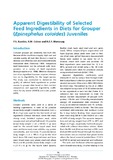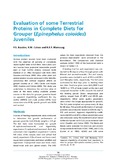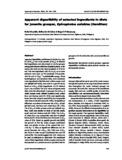Detection of betanodaviruses from different organs of broodstocks and wild juveniles of orange-spotted grouper, Epinephelus coioides
| dc.contributor.author | Kiryu, Ikunari | |
| dc.contributor.author | de la Peña, Leobert D. | |
| dc.contributor.author | Maeno, Yukio | |
| dc.contributor.editor | Nakamura, Koji | |
| dc.date.accessioned | 2023-08-29T02:21:26Z | |
| dc.date.available | 2023-08-29T02:21:26Z | |
| dc.date.issued | 2006 | |
| dc.identifier.issn | 1341-710X | |
| dc.identifier.uri | http://hdl.handle.net/10862/6472 | |
| dc.description.abstract | Aquaculture of grouper including orange-spotted grouper suffers losses from viral nervous necrosis (VNN). This disease usually occurs in larval stage resulting in a high rate of mortality. It is conceivable that vertical transmission from subclinically infected broodstock fish to the brood is the major route of infection. However, there are only a few studies regarding the fish subclinically infected with VNN and the evidence for a causal relationship between subclinically infected adult fish and vertical transmission remains tenuous. The purpose of this study is to reveal the distribution of the virus in asymptomatically infected fish. Six healthy broodstocks of orange-spotted groupers with body weights ranging from 5 to 12 kg were used and 14 different organs were collected. Cell culture and PCR methods were used to detect the virus. Additionally, 8 wild juveniles with body weights ranging from 2 to 4 g were also analyzed. In our results, the virus was detected by means of PCR but not by the cell culture method. All the broodstocks and wild juveniles were positive in the PCR test except for one juvenile. The highest detection rate of the virus among organs was the brain. However, the virus gene was also amplified from organs other than the central nervous system (CNS). We hypothesize that the virus was latently retained in the CNS of subclinically infected fish and when the fish immune system was weakened such latent virus was released from CNS to the peripheral organs including the gonad. This mechanism might provoke the vertical transmission infection. | en |
| dc.language.iso | en | en |
| dc.publisher | Japan International Research Center for Agricultural Sciences | en |
| dc.relation.ispartofseries | JIRCAS Working Report; No. 44 | |
| dc.subject | groupers | en |
| dc.subject | Epinephelus coioides | en |
| dc.title | Detection of betanodaviruses from different organs of broodstocks and wild juveniles of orange-spotted grouper, Epinephelus coioides | en |
| dc.type | Book chapter | en |
| dc.citation.spage | 53 | en |
| dc.citation.epage | 55 | en |
| dc.citation.bookTitle | Sustainable Production Systems of Aquatic Animals in Brackish Mangrove Areas | en |
| dc.subject.asfa | breeding stock | en |
| dc.subject.asfa | juveniles | en |
| dc.subject.asfa | viroses | en |
| dc.subject.scientificName | Epinephelus coioides | en |
| local.subject | Grouper | en |
| local.subject | broodstocks | en |
| local.subject | wild juveniles | en |
| local.subject | viral nervous necrosis (VNN) | en |
このアイテムのファイル
| ファイル | サイズ | フォーマット | 閲覧 |
|---|---|---|---|
|
このアイテムに関連するファイルは存在しません。 |
|||
このアイテムは次のコレクションに所属しています
-
Books and Book Chapters [123]




